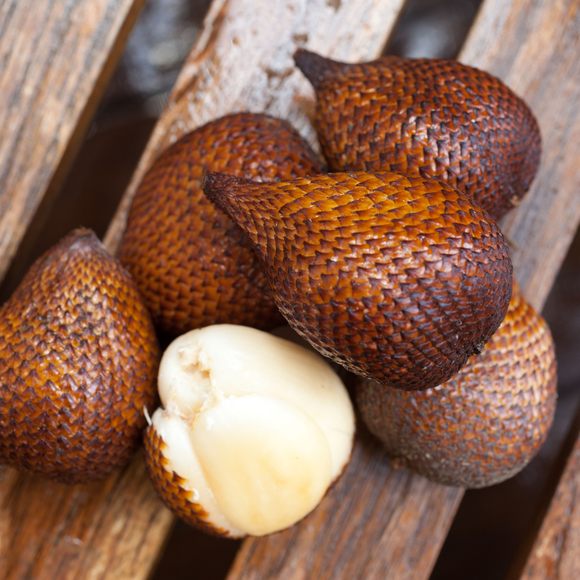Salacca is a genus of Southeast Asian palm fruits that look so snake-like you might expect one to be venomous. Many of the brutally bitter, sour varieties are solely used in cooking, but the commonly cultivated Salacca zalacca is typically enjoyed out of hand. In Indonesia, this fruit is known as “salak,” but its thin, scale-like skin has earned it a more suitable nickname: “snakefruit.”
Salak trees are covered in sharp spikes, so harvesting the fruits takes skill. After retrieving a morsel, hungry harvesters will typically open it by pinching the tip to break the skin, then peeling against the grain of the scales. Inside is a hard, pale yellow pulp that breaks apart into three lobes resembling large cloves of garlic. A properly ripened snakefruit is dry and crunchy, with a taste similar to a bitter pineapple or jackfruit. The pulp is commonly eaten raw, but is also used to make wine, juices, and candies.
Most varieties of salak have an astringency to them, which is something that can take getting used to. There is a thin film surrounding each lobe of pulp, which, if peeled, can remove some of the astringent taste. However, some consumers of the fruit swear that leaving that thin membrane intact will help keep you regular. But not too much: Excessive consumption of snakefruit is said to cause constipation.
Written By
 Jared Rydelek
Jared Rydelek
Sources
- www.smithsonianmag.com/arts-culture/meet-the-salak-the-ubiquitous-indonesian-fruit-youve-never-heard-of-115942678/
- migrationology.com/snake-fruit-salak/
- books.google.com/books?id=VBTRAgAAQBAJ&pg=PT54&dq=salak+snakefruit&hl=en&sa=X&ved=0ahUKEwiQ_cykydXZAhXGTd8KHcJmDfo4ChDoAQhRMAg#v=onepage&q=salak%20snakefruit&f=false
The Atlas Obscura Podcast is Back!















